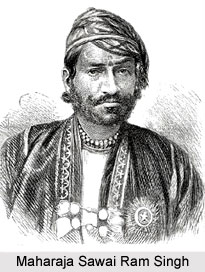 Maharaja Sawai Ram Singh 11 became the king of Jaipur as a child in 1835 but came to power in 1854. As he was a minor at that time the administration of the State was handled by the Minority Council. As he grew up Ram Singh was known for his intelligence, the way he carried out his responsibilities and the State affairs. He could easily get into the details of administration. Ram Singh is credited with reforming and modernizing the city of Jaipur. The first major change was brought about by Maharaja Sawai Ram Singh II. After Maharaja Sawai Jai Singh II, he is considered as the most enlightened of the Jaipur rulers.
Maharaja Sawai Ram Singh 11 became the king of Jaipur as a child in 1835 but came to power in 1854. As he was a minor at that time the administration of the State was handled by the Minority Council. As he grew up Ram Singh was known for his intelligence, the way he carried out his responsibilities and the State affairs. He could easily get into the details of administration. Ram Singh is credited with reforming and modernizing the city of Jaipur. The first major change was brought about by Maharaja Sawai Ram Singh II. After Maharaja Sawai Jai Singh II, he is considered as the most enlightened of the Jaipur rulers.
Administration of Maharaja Sawai Ram Singh
Maharaja Sawai Ram Singh is regarded a great ruler especially during the most crucial moment in history. During his reign Mughal Empire was stumbling after ruling for nearly three centuries. On the other hand the Britishers were also gradually establishing their rule in India. The British East India Company had rightfully extended its influence throughout the country. Maharaja Sawai Ram Singh soon realised the state of affairs and closely observed the new changes and developments of the country and his city. He thus took all the necessary measures to introduce new reform movements, improvements and developments that were required for his city. He is known for giving s shape to Jaipur and equipping it with all the required modern amenities. He soon established peace and tranquillity in the state and from 1860`s he began shouldering the responsibility of the administration and welfare of his people. He took a keen interest in towards the welfare and improvement of his citizens. He is credited with building the Jaipur Water Works (1875), Gas Works (1878), the Mayo Hospital, the Ramniwas Gardens with the Museum, School of Arts, Public Library, Ramprakash Theatre, Maharaja`s College (1844), Sanskrit School (1865), the Noble`s School (1862), the Girls School (1867) for the utility of the general public. The Public Works Department was established in 1860. He also gave the instruction for the construction of roads and highways between Jaipur, Ajmer and Agra. Maharaja Sawai Ram Singh was also a great social reformer. Dams for irrigation purposes, public buildings, and offices were also built under his initiative. During his reign many evil social customs like slavery, child infanticide, and sati were officially abolished in the State of Jaipur. The Maharaja also made great contributions in the field of literature. The lithographic press that was established by him added many valuable books to the Pothikhana.
Maharaja Sawai Ram Singh also had a keen interest towards modern developments. He is said to be the first Photographer Prince of India. He also initiated the development of formal course in Photography in an institution other than a photography studio. He also owned a personal studio or `photukhana` which had the latest and best of equipment. He was a member of the Bengal Photographic Society. He had employed an English photographer. Together they captured many valuable photographs of old Jaipur and also recorded the construction of the city and its buildings. It is through these priceless photographs that one can get a glimpse of the society, people, their culture, costumes of that period of Jaipur. Ram Singh was also an ardent devotee of Lord Shiva.
Education Policy of Sawai Ram Singh
Maharaja Sawai Ram Singh had introduced many educational policies. He is instrumental in establishing the Maharaja`s College. It gave education in Sanskrit, Urdu and English. Later it was divided to establish the separate Sanskrit College. More than 800 students studied here in the college. The Maharaja also started the Rajput School, the Medical School, the Girls` School, the School of Art, the Public Library, a printing press, the Ram Prakash Theatre, a meteorological observatory and Mayo Hospital. School of Art was also opened in 1866 by Maharaja Sawai Ram Singh. The curriculum included methods of local traditional crafts. May students enrolled here to learn the methods of wood carving and carpentry.
Recognising and honouring his valuable contribution The British Government nominated twice as a member of the newly formed Viceroy`s Legislative Council, and by adding four guns to his salute. The title of G.C.S.I. was also bestowed upon him. In 1877 i.e. three years before his death, he became a member of the Privy Council.






